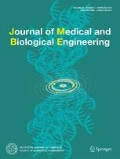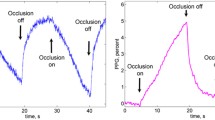Abstract
Sudden changes in blood pressure are frequently caused by daily events such as exercise, stressful work, and moving between different temperature environments. Sometimes, an abrupt change in blood pressure can endanger human lives. To mitigate such a risk, several studies have previously proposed contactless methods for monitoring changes in blood pressure; however, the number of studies on this issue is insufficient. In previous methods, changes in blood pressure were estimated using the propagation time of the pulse waves obtained from two different skin areas on the basis of an analysis of images from video recordings, which is called a video plethysmogram. However, the relative positional relationship of the two skin areas had to be maintained during the measurement, making the approach restrictive. To solve this problem, in the present study, we propose a new method using the video plethysmogram obtained from only one skin area. In particular, the degree of distortion in the video plethysmogram is calculated as a new index to estimate the blood pressure. On the basis of the results of our experiments with 20 healthy human subjects, we ascertain that the proposed index obtained from the palm area is correlated with the blood-pressure variability as well as the previous approach.










Similar content being viewed by others
References
Takano, C., & Ohta, Y. (2007). Heart rate measurement based on a time-lapse image. Medical Engineering & Physics, 29, 853–857.
Verkruysse, W., Svaasand, L. O., & Nelson, J. S. (2008). Remote plethysmographic imaging using ambient light. Optics Express, 16(22), 21434–21445.
Poh, M., McDuff, D. J., & Picard, R. W. (2010). Non-contact, automated cardiac pulse measurements using video imaging and blind source separation. Optics Express, 18(10), 10762–10774.
Poh, M., McDuff, D. J., & Picard, R. W. (2011). Advancements in noncontact, multiparameter physiological measurements using a webcam. IEEE Transactions on Biomedical Engineering, 58(1), 7–11.
Sun, Y., Hu, S., Azorin-Peris, V., Greenwald, S., Chambers, J., & Zhu, Y. (2011). Motion-compensated noncontact imaging photoplethysmography to monitor cardiorespiratory status during exercise. Journal of Biomedical Optics, 16(7), 077010.
Sun, Y., Papin, C., Azorin-Peris, V., Kalawsky, R., Greenwald, S., & Hu, S. (2012). Use of ambient light remote photoplethysmographic systems: Comparison between a high-performance camera and a low-cost webcam. Journal of Biomedical Optics, 17(3), 037005.
Zhao, F., Li, M., Qian, Y., & Tsien, J. Z. (2013). Remote measurements of heart and respiration rates for telemedicine. PLoS ONE, 8(10), e71384.
Bousefsaf, F., Maaoui, C., & Pruski, A. (2013). Continuous wavelet filtering on webcam photoplethysmographic signals to remotely assess the instantaneous heart rate. Biomedical Signal Processing and Control, 8, 568–574.
Aarts, L. A. M., Jeanne, V., Cleary, J. P., Lieber, C., Nelson, J. S., Oetomo, S. B., et al. (2013). Non-contact heart rate monitoring utilizing camera photoplethysmography in the neonatal intensive care unit—A pilot study. Early Human Development, 89, 943–948.
Tarassenko, L., Villarroel, M., Guazzi, A., Jorge, J., Clifton, D. A., & Pugh, C. (2014). Non-contact video-based vital sign monitoring using ambient light and auto-regressive models. Physiological Measurement, 35, 807–831.
Monkaresi, H., Calvo, R. A., & Yan, H. (2014). A machine learning approach to improve contactless heart rate monitoring using a webcam. IEEE Journal of Biomedical and Health Informatics, 18(4), 1153–1160.
Shao, D., Yang, Y., Liu, C., Tsow, F., Yu, H., & Tao, N. (2014). Non-contact monitoring breathing pattern, exhalation flow rate and pulse transit time. IEEE Transactions on Biomedical Engineering, 61(11), 2760–2767.
Kong, L., Zhao, Y., Dong, L., Jian, Y., Jin, X., Li, B., et al. (2013). Non-contact detection of oxygen saturation based on visible light imaging device using ambient light. Optics Express, 21(15), 17464–17471.
Shaog, D., Liu, C., Tsow, F., Yang, Y., Du, Z., Iriya, R., et al. (2016). Noncontact monitoring of blood oxygen saturation using camera and dual-wavelength imaging system. IEEE Transactions on Biomedical Engineering, 63(6), 1091–1098.
Sugita, N., Obara, K., Yoshizawa, M., Abe, M., Tanaka, A., & Homma, N. (2015). Techniques for estimating blood pressure variation using video images. In Proceedings of the 37th Annual International Conference of the IEEE Engineering in Medicine and Biology Society (pp. 1146‒1151).
Jeong, I. C., & Finkelstein, J. (2016). Introducing contactless blood pressure assessment using a high speed video camera. Journal of Medical Systems, 40, 77.
Secerbegovic, A., Bergsland, J., Halvorsen, P. S., Suljanovic, N., Mujcic, A., & Balasingham, I. (2016). Blood pressure estimation using video plethysmography. In Proceedings of IEEE 13th International Symposium on Biomedical Imaging (pp. 461‒464).
Jain, M., Deb, S., & Subramanyam, A. V. (2016). Face Video Based Touchless Blood Pressure and Heart Rate Estimation. In Proceedings of IEEE 18th International Workshop on Work Multimedia Signal Processing.
Collins, K. J., Easton, J. C., Belfield-Smith, H., Exton-Smith, A. N., & Pluck, R. A. (1985). Effects of age on body temperature and blood pressure in cold environments. Clinical Science, 69, 465–470.
Yochihara, Y., Ohnaka, T., Nagai, Y., Tokuda, T., & Kawashima, Y. (1993). Physiological responses and thermal sensations of the elderly in cold and hot environments. Journal of Thermal Biology, 18(5–6), 355–361.
Kandai, K., Tsuchiya, J., Seto, M., Ohnaka, T., & Tochihara, Y. (1995). Thermal conditions in the bathroom in winter and summer, and physiological responses of the elderly during bathing. Japanese Journal of Hygiene, 50, 595–603.
Kamshilin, A. A., Nippolainen, E., Sidorov, I. S., Vasilev, P. V., Erofeev, N. P., Podolian, N. P., et al. (2015). A new look at the essence of the imaging photoplethysmography. Scientific Reports, 5, 10494.
Gribbin, B., Steptoe, A., & Sleight, P. (1976). Pulse wave velocity as a measure of blood pressure change. Psychophysiology, 13(1), 86–90.
Chen, W., Kobayashi, T., Ichikawa, S., Takeuchi, Y., & Togawa, T. (2000). Continuous estimation of systolic blood pressure using the pulse arrival time and intermittent calibration. Medical & Biological Engineering & Computing, 38(5), 569–574.
Mukkamala, R., Hahn, J. O., Inan, O. T., Mestha, L. K., Kim, C. S., Töreyin, H., et al. (2015). Towards ubiquitous blood pressure monitoring via pulse transit time: Theory and practice. IEEE Transactions on Biomedical Engineering, 62(8), 1879–1901.
Sharma, M., Barbosa, K., Ho, V., Griggs, D., Ghirmai, T., Krishnan, S. K., et al. (2017). Cuff-less and continuous blood pressure monitoring: A methodological review. Technologies, 5, 21.
Sifil, A., Bednarz, D., Larive, B., Garcia, M., Lau, S. M., & Paganini, E. P. (2003). Evaluation of the harmonized alert sensing technology device for hemodynamic monitoring in chronic hemodialysis patients. ASAIO, 49(6), 667–672.
Payne, R. A., Symeonides, C. N., Webb, D. J., & Maxwell, S. R. J. (2006). Pulse transit time measured from the ECG: An unreliable marker of beat-to-beat blood pressure. Journal of Applied Physiology, 100(1), 136–141.
Gu, W. B., Poon, C. C. Y., & Zhang, Y. T. (2008). A novel parameter from PPG dicrotic notch for estimation of systolic blood pressure using pulse transit time. In Proceedings of 5th International Summer School and Symposium on Medical Devices and Biosensors (pp. 86‒88).
Shriram, R., Wakankar, A., Daimiwal, N., & Ramdasi, D. (2010). Continuous cuffless blood pressure monitoring based on PTT. In Proceedings of International Conference on Bioinformatics and Biomedical Technology (pp. 51‒55).
Proença, J., Muehlsteff, J., Aubert, X., & Carvalho, P. (2010). Is pulse transit time a good indicator of blood pressure changes during short physical exercise in a young population? In Proceedings of the 32nd Annual International Conference of the IEEE Engineering in Medicine and Biology Society (pp. 598‒601).
Frits, F. M. M., Fernando, M., Andries, J. S., & Reindert, G. (2005). A model for post-occlusive reactive hyperemia as measured with laser-doppler perfusion monitoring. IEEE Transactions on Biomedical Engineering, 52(2), 184–190.
Kortekaas, M. C., Niehof, S. P., Velzen, M. H. N., Galvin, E. M., Stolker, R. J., & Huygen, F. J. P. M. (2012). Comparison of bilateral pulse arrival time before and after induced vasodilation by axillary block. Physiological Measurement, 33, 1993–2002.
MathWorks, Inc., Documentation of MATLAB Signal Processing Toolbox. Retrieved from https://www.mathworks.com/help/signal/ref/findpeaks.html.
Ruiz-Rodríguez, J. C., Ruiz-Sanmartín, A., Ribas, V., Caballero, J., García-Roche, A., Riera, J., et al. (2013). Innovative continuous non-invasive cuffless blood pressure monitoring based on photoplethysmography technology. Intensive Care Medicine, 39, 1618–1625.
Li, Y., Wang, Z., Zhang, L., Yang, X., & Song, J. (2014). Characters available in photoplethysmogram for blood pressure estimation: Beyond the pulse transit time. Australasian Physical and Engineering Science in Medicine, 37(2), 367–376.
Shin, H., & Min, S. D. (2017). Feasibility study for the non-invasive blood pressure estimation based on ppg morphology: Normotensive subject study. BioMedical Engineering OnLine, 16, 10.
Porth, C. J., Bamrah, V. S., Tristani, F. E., & Smith, J. J. (1984). The Valsalva maneuver: Mechanisms and clinical implications. Heart and Lung, 13(5), 507–518.
Kamshilin, A. A., Zaytsev, V. V., & Mamontov, O. V. (2017). Novel contactless approach for assessment of venous occlusion plethysmography by video recordings at the green illumination. Scientific Reports, 7, 464.
Izumi, H., & Karita, K. (1992). Somatosensory stimulation causes autonomic vasodilation in cat lip. Journal of Physiology, 450, 191–202.
Drummond, P. D. (1995). Mechanisms of physiologicaigustatory sweating and flushing in the face. Journal of the Autonomic Nervous System, 52, 117–124.
Acknowledgements
Part of this work was supported by the COI Stream Project founded by Japanese Ministry of Education, Science, Sports and Culture.
Author information
Authors and Affiliations
Corresponding author
Ethics declarations
Conflict of interest
The authors declare that there is no conflict of interest.
Ethical Approval
All procedures performed in studies involving human participants were in accordance with the ethical standards of the institutional and/or national research committee and with the 1964 Helsinki declaration and its later amendments or comparable ethical standards.
Informed Consent
Informed consent was obtained from all individual participants included in the study.
Rights and permissions
About this article
Cite this article
Sugita, N., Yoshizawa, M., Abe, M. et al. Contactless Technique for Measuring Blood-Pressure Variability from One Region in Video Plethysmography. J. Med. Biol. Eng. 39, 76–85 (2019). https://doi.org/10.1007/s40846-018-0388-8
Received:
Accepted:
Published:
Issue Date:
DOI: https://doi.org/10.1007/s40846-018-0388-8




